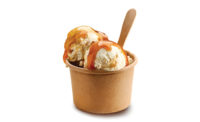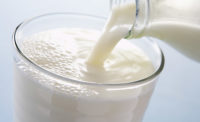
For The Health of It
by Julie Cook
Amid the low-carb craze and challenges from soy, hopes
for milk are high due to weight-loss claims.
When New York City-based Beverage Marketing Corp. laid out its
"Ten Trends Shaping Today's Beverage Industry" in March 2003, health and wellness
took the top spot Was the "single most important driving force shaping today's
beverage consumption."
It seems only natural, then, that milk —
nature's original source of calcium and other nutrients — would
stand to benefit from the trend toward healthy beverages.
Sadly, that has not turned out to be the case, as
fluid milk sales were flat or down across the board during the 52-week
period ending January 25, 2004. According to Chicago-based Information
Resources Inc. (IRI), whole milk sales rose a meager 0.7 percent in
dollars, but fell 1.5 percent in units, while skim/lowfat milk fell 1.0 and
3.2 percent, respectively. Even flavored milk — the only subcategory
to exhibit much promise in recent years — stumbled, as dollar sales
increased 0.4 percent and unit sales fell 1.8 percent.
Ironically, consumers' fervent desire to lose
weight and lead healthier lives might actually be working against milk.
While the verdict is still out as to how much of an impact the current
low-carbohydrate craze of the Atkins and South Beach diets is having on
milk sales, processors agree the trend cannot be ignored.
"The low-carb craze is probably the biggest
thing that's happened to the food industry in the last decade in
terms of a really significant change in eating patterns," says Rachel
Kyllo, vice president of marketing for Minneapolis-based Marigold Foods
LLC, which sells milk under the Kemps brand name. "I don't know
that we understand how that has affected fluid milk, but we as an industry
have to wrap our arms around that and get a better understanding of
it."
To counter the Atkins diet impact, Des Moines,
Iowa-based Anderson Erickson Dairy Co. (AE) recently rolled out its
Chocolate Fat-Free Skim Milk. Sweetened with Splenda® brand sucralose,
this skim milk has 14 grams of carbohydrates — half that of regular
sugar-sweetened chocolate milk — and a third fewer calories.
"Right now, the big trend is low carbs,"
says Betsy Watson, AE's marketing specialist. "Consumers
are really watching their carb intake, and we need to think outside the box
as far as how to entice Atkins dieters to consume dairy
products."
Sharing that mindset, Chelsea, Mass.-based HP Hood
introduced its new Carb Countdown line, consisting of four low-carb
dairy-based beverages: Homogenized; 2% Reduced Fat; Fat Free; and 2%
Reduced Fat Chocolate. Likewise, Davenport, Iowa-based Swiss Valley Farms
launched a no-sugar-added chocolate milk, containing half the carbs of
regular chocolate milk. Available in half-gallon jugs, the milk is designed
to appeal to Atkins dieters, as well as diabetics and parents who want to
reduce their kids' sugar intake, according to Ron Schroder, director
of marketing.
Phoenix-based Shamrock Foods also recently rolled out
a no-sugar-added 1% chocolate milk. This Splenda-sweetened product is
available in 12- and 32-ounce sizes. And following the success of its
low-carb Splenda-sweetened ice cream, Syracuse, N.Y.-based Byrne Dairy
plans to introduce a line of Splenda-sweetened milk in skim, 1%, 2% and
whole varieties this year.
| Top 10 Refrigerated Flavored Milk/Eggnog/Buttermilk Brands* | |||||
|   |
$ Sales
(In Millions)
|
% Change
vs. Year Ago
|
Dollar
Share
|
Unit Sales
(InMillions)
|
% Change
vs. Year Ago
|
| Total Category | $754.2 |
0.4% |
100.0 |
426.7 |
-1.8% |
| Private Label | 216.2 |
2.4 |
28.7 |
112.4 |
0.7 |
| Nestlé Nesquik | 114.8 |
-0.2 |
15.2 |
65.2 |
-1.1 |
| Dean's | 33.4 |
2.0 |
4.4 |
20.7 |
-3.2 |
| Kemps | 19.2 |
0.8 |
2.6 |
10.4 |
-3.4 |
| Borden | 13.9 |
-4.7 |
1.9 |
6.8 |
-9.0 |
| Hershey's | 13.9 |
0.2 |
1.8 |
5.2 |
-4.4 |
| Mayfield | 12.3 |
-1.5 |
1.6 |
6.7 |
-6.5 |
| Garelick | 11.4 |
16.0 |
1.5 |
6.1 |
12.7 |
| Hershey's-Morningstar | 11.0 |
22.4 |
1.5 |
9.9 |
18.2 |
| Prairie Farms | 10.6 |
6.8 |
1.4 |
6.4 |
2.8 |
| * Total sales in supermarkets, drug stores and mass merchandisers, excluding | |||||
| Wal-Mart, for the 52-week period ending January 25, 2004. | |||||
| SOURCE: Information Resources Inc. | |||||
| Refrigerated Top 10 Vendors* (by dollar share) | |||||||||||||||||||||||||||||||||||||||||||||
|
|
||||||||||||||||||||||||||||||||||||||||||||
| * Total sales in supermarkets, drug stores
and mass merchandisers, excluding Wal-Mart, for the 52-week period ending January 25, 2004. SOURCE: Information Resources Inc. Note: Complete data for the skim/lowfat and whole categories was not available from IRI. |
|||||||||||||||||||||||||||||||||||||||||||||
At Seattle-based WestFarm Foods, which has several
low-carb products in development, director of marketing Randy Eronimous
says he has not been impressed by the low-carb products currently on the
market. "Many of the low-carbohydrate products that I've tried
fall into the 'not bad' category," he says. "If the
best thing you can say about a product is, 'It's not
bad,' you know you're not destined for greatness."
Threat Assessment
That said, Eronimous believes the growing low-carb
movement poses a much greater threat to the fluid milk business than
soymilk. While processors long have been sensitive about the use of the
term "milk" to describe a non-dairy beverage, a growing number
of dairies have jumped on the soy bandwagon. For example, WestFarm co-packs
soymilk for a national brand, while Swiss Valley is exploring the
possibility of developing a hybrid soy protein/dairy milk product.
Meanwhile, Producers Dairy Inc., Fresno, Calif.,
recently announced the introduction of Producers Soymilk, a lowfat,
low-sodium, cholesterol-free beverage described as "great for shakes,
smoothies, baking, cereal or drinking cold or warm." Available in
Original and Vanilla flavors, the calcium- and vitamin-enriched product is
promoted as "a healthy alternative to cow's milk."
Tom Nagle, vice president of marketing for the
International Dairy Foods Association (IDFA), Washington, D.C., is likely
to take exception with that claim, as he reports that soymilk has been
found to be not nearly as good as delivering essential nutrients as the
genuine article. According to Nagle, that's one of the reasons why
soymilk will never be able to give cow's milk a real run for its
money.
"There's a very high percentage of
reputable scientists around the world who are willing to say that the
nutritional delivery of soymilk is not comparable to real milk," says
Nagle. "It's a very successful growing niche product, but I
still don't think its primary competition is with the core fluid milk
business."
Soymilk manufacturers may have thought they were about
to hit on their big break when bovine spongiform encephalopathy (BSE), commonly known as
mad cow disease, surfaced in the United States last fall. Processors admit
they expected to be fielding a flood of calls from concerned consumers
after one infected dairy cow was discovered in Washington state. But such
an onslaught never materialized, and mad cow appears to have had little or
no impact on the milk industry.
"The safety of milk was never really called into
question," says David Pelzer, spokesman for Dairy Management Inc.
(DMI), Rosemont, Ill. "In a couple of cases where people raised
issues, we jumped on that right away, contacted the news organizations and
made sure they were aware of statements by the FDA (Food and Drug
Administration) and the World Health Organization, verifying and
reaffirming the safety of milk."
Weighty Matters
No doubt, the dairy industry welcomed such news with
open arms, as a widespread scare regarding the safety of milk would have
seriously impacted the potential of the long-awaited "Healthy Weight
with Dairy" campaign, launched in October by IDFA, DMI and the Milk
Processor Education Program (MilkPEP). The campaign centers around
scientific research undertaken more than five years ago that suggests a
link between dairy consumption and body weight control. With a combination
of national advertising and local marketing, Healthy Weight with Dairy is
reminding consumers that milk, cheese and yogurt, as part of a
reduced-calorie, lowfat diet, may help weight-loss efforts.
"Dairy farmers had the foresight and the insight
to fund the research, and as a result, we have the most powerful story that
any marketer could wish for in terms of the obesity crisis," says Tom
Gallagher, DMI chief executive officer. "The study shows that this
country would reduce health care costs by $209 billion in five years if
Americans were to get three to four servings of dairy each day. It's
just information that cannot be ignored."
Processors are encouraged to sign up for a license
from IDFA allowing them to include the weight-loss claim in product
packaging and marketing efforts.
But Nagle is quick to add that IDFA and other industry
groups have no intention of turning dairy into the next dieting fad.
"We're not trying to promote a milk diet per se. We don't
want the weight-loss properties of milk to become the next fad diet,"
he says. "We're looking at this as a potentially long-term
benefit that could give a long-term increase to the core volume."
That core volume is white milk in take-home packages.
After several years of hearing about the immense potential of flavored
products, processors finally have a reason to celebrate good old gallon
jugs of white milk.
That's not to suggest that single-serve flavored
milks are past their prime. In fact, single-serve milk remains key to
fulfilling the immense potential offered by schools, vending and
foodservice — three other key areas of interest for DMI, IDFA and
MilkPEP.
"We see the foodservice channel as a real
significant opportunity for fluid milk," says Grant Prentice,
DMI's executive vice president of marketing and business development.
"It's very underdeveloped currently, both in terms of the
variety of milks that are offered and also the way it's merchandised
relative to other beverages."
So DMI has begun running tests in partnership with the
Wendy's and McDonald's fast-food chains to gauge the potential
for increasing milk sales in quick-service restaurants. In addition, the
organization continues its school vending efforts. According to Gallagher,
if DMI's test results were to be replicated nationwide, more than 67
million additional gallons would be sold each year in schools alone.
That finding hasn't escaped the folks at
Anderson Erickson, which sells its Icy Cold to Go single-serve milks
through 22 vending machines in grade schools and high schools, as well as
convenience stores. Likewise, Byrne Dairy has placed school vending
machines primarily in high schools. Playing to the tastes of young people,
Byrne recently added lowfat Cookies N' Cream 1% milk to its pint
line.
According to Annette Jim, Byrne's director of
marketing, extended shelf-life products hold the key to vending success. In
fact, Byrne's new ultra-pasteurized plant in De Witt, N.Y., will
allow the dairy to produce longer-code-dated products. Of course, merely
extending the shelf life of milk will not eliminate all the challenges
inherent in vending.
"With a Pepsi machine, if it gets unplugged, it's not a big
deal — you just plug it back in," says Jim. "With milk, they have to make sure
it stays cooled all the time and that they keep their code dates fresh so it
doesn't spoil."
Julie Cook is a freelance journalist based in the Chicago
area.
$OMN_arttitle="For The Health of It";?>
